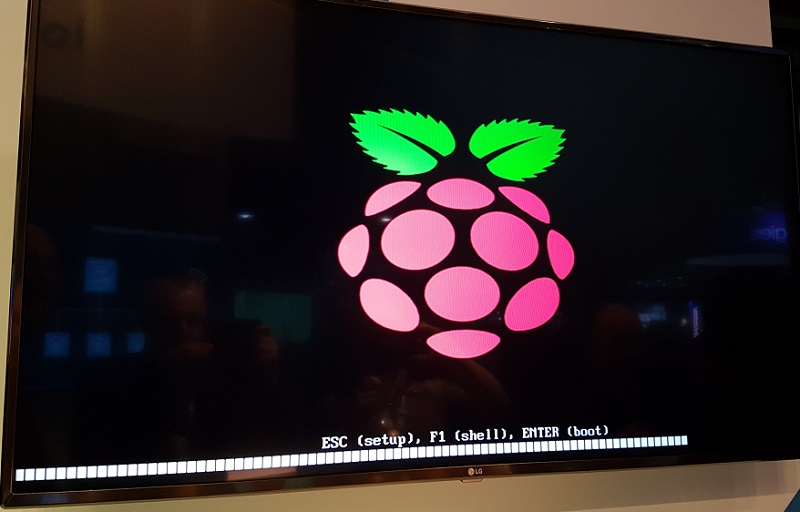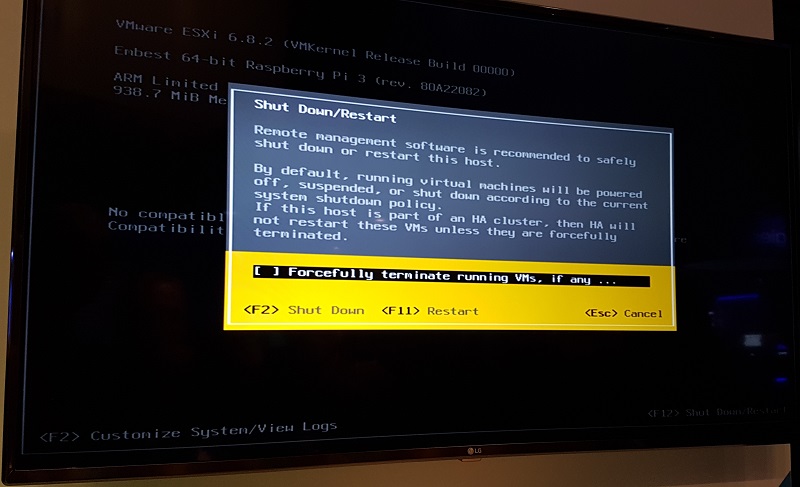During the VMworld US 2018, one of the announces was the VMware ESXi for ARM porting, specific for the embedded and edge IoT systems, so not like a general purpose solution for all ARM servers (but an interesting move to increase the possibility for bringing the virtualization on ARM).
VMware demonstrated ESXi on 64-bit ARM running on ARM hardware built to common industry standards; note that VMware demonstrates not just virtualization, but also resilient operations and ease of management at the Edge, via FT-protected 64-bit Arm VMs and vMotion in a high-availability DRS cluster…
And also during the first keynote, there was a place for this announce:
Apparently when I ask @PGelsinger, @ray_ofarrell, and @cswolf, “ESXi on @Raspberry_Pi?” at the #vmworld ‘#VMUG Leader Lunch’ in Vegas…they do something like this a few months later…https://t.co/kdOLQ1Wwx3
Sure I’m not the only person to ask this…but still! 😱🤯#vCommunity— Richard Kenyan (@RichardKenyan) 6 novembre 2018
Now at the last VMworld EU 2018, there was a working demo of VMware ESXi on Raspberry Pi, the small platform with very interesting cost and an impressing set of options:
[amazon_link asins=’B01CD5VC92,B07BDR5PDW,B01HV97F64′ template=’ProductCarousel’ store=’vinfrastructu-20′ marketplace=’US’ link_id=’c53b5347-e3e7-11e8-b50a-89a1962be92c’]
VMware has announced this solution for selected OEM partners, so seems really a solution that will be available as an embedded pre-packaged box. But now seems more than that and for sure it becomes more real also on small systems.
At the IoT Solution stand there was a working demo running on generic Raspberry Pi platforms:
The system was incredibly fast in the bootup process:
Note the version of ESXi: 6.8 version is the same used for VMware Cloud on AWS, were the ESXi are optimized with specific drivers.
In few minutes the system was loaded and the beauty is that it can be managed as a common ESXi, with same functions, same UI (including connecting it to a vCenter server) and same logic:
Note that it’s running on a system with only 1 GB of RAM… incredible less than the 4 GB minimum requirement for the “full” ESXi x86 version!
But where this solution can make sense?
The main answer it’s in the specific use cases of embedded and edge IoT systems: it’s a specific field and has this opportunity could be interesting.
VMware has identified three main use cases of this solution:
- ESXi node with no workload: seems crazy? Not at all… a Raspberry Pi could be a fantastic solution for a vSAN witness node… and not necessary for a lab purpose, but also for production, where maybe the third site is limited on space, or other facilities (like powering and cooling).
- ESXi node(s) with one single business-critical workload: of course we are talking about a workload for ARM platform (for examples used in a production line). But how can you use a Rasberry Pi for a critical workload? You can use a two nodes configuration with a fast direct network and use vSphere FT to make this workload fault tolerance! Clever and also you can easily move the workload or just protect is with backup solutions.
- ESXi node(s) with few workloads: in this case you realize and edge system (or an edge cluster with two/three nodes) to run some edge workloads and benefit from VMware functions like vMotion, FT (if needed), data protection, …
The first case is quite interesting and not related at all with IoT area… But there are, of course, questions on the reliability of the solution and also if really can work in practice (vSAN has system requirement little higher than a normal ESXi)… but the idea is very nice.
And what about the computing power that could be requested? Edge use case is quite different from datacenter use case… Less computing on each node, but several distributed nodes.
There is an interesting video from VMworld TV with other information about this solution:
For the general purpose server the answer actually it’s too far (see: VMware ESXi for ARM: make sense?). Not for the power itself, because there are some ARM based systems with a lot of computing power (Monday: Intel teases 48-core Xeon. Tuesday: AMD whips covers off 64-core second-gen Epyc server processor), but instead for the workloads that should be rewritten for the ARM platform… In the future, maybe we can have a shift or have a rise of cross-platform workloads….
Also if it’s (or will) possible run ESXi on different other ARM based system, like Marvell MACCHIATObin and SolidRun ClearCloud 8K Edge Gateway, this does not mean that they will be used for generic workload, but still IoT or specific use cases.
Finally, it could really be nice have the “optimized version” of ESXi also of a nested environment in the generic x86 platforms: why we still need the general version of ESXi in it runs in a virtual environment and does NOT need all the device drivers (and probably neither all the code)? Isn’t better for lab purpose (at least) have also the customized and optimized ESXi?
See also:
- VMware ESXi for ARM: make sense?
- ESXi on a Raspberry Pi
- VMworld 2018 Europe – Alexander Fainkichen – ESXi on a Raspberry Pi







